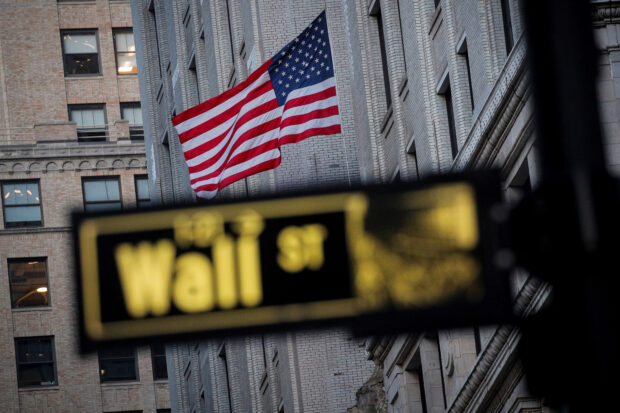Take Five: A quiet start to 2024? No way

The U.S. flag is seen on a building on Wall St. in the financial district in New York, U.S., Nov 24, 2020. REUTERS/Brendan McDermid
LONDON – There’s not much time to get over the New Year’s partying: the most closely watched U.S. economic release and key euro area inflation data are on the calendar in the week ahead, suggesting a busy start to 2024.
With hopes high for big central banks to start cutting interest rates soon, euphoric financial markets could soon be tested, while the timing of a Bank of Japan rate increase remains in focus.
Here’s your look ahead to the first trading week of the new year with Kevin Buckland in Tokyo, Yoruk Bahceli in Amsterdam, Ira Iosebashvili in New York and Dhara Ranasinghe in London.
1.Goldilocks, stick around
The health of the U.S. jobs market is crucial to gauging whether a Goldilocks scenario continues into 2024, putting Friday’s December non-farm payrolls report in the spotlight.
Economic growth has cooled and inflation has eased, fueling a massive cross-asset rally and allowing the Federal Reserve to pencil in more rate cuts for 2024. At the same time, the economy has shown little evidence that months of tighter monetary policy are spawning a severe downturn.
Signs of deviation from that scenario – in the form of exceedingly strong jobs growth or a sudden drop in employment – could shake investors’ confidence in a soft landing.
READ: US job openings lowest in more than 2-1/2 years
Economists polled by Reuters expect the U.S. economy added 158,000 jobs in December versus 199,000 in November.
2. Inflation surprise?
For all the joy in markets, data also out on Friday is expected to show euro zone inflation rose in December for the first time since April.
READ: ECB expects euro zone 2024 inflation to remain above 3% – source
A Reuters poll sees it jumping to 3 percent from 2.4 percent in November, snapping a sharp drop which saw inflation undershoot expectations for three straight months.
Economists reckon the rise will largely result from energy support measures a year ago, particularly in Germany, where the government had covered household gas bills, meaning a lower “base” to which December 2023 prices are compared.
So, investors will have to sift through the data to assess how current price pressures are evolving. Any surprise higher would unnerve traders expecting over six, quarter-point ECB rate cuts in 2024.
The good news: core inflation, excluding volatile food and energy prices, should continue dropping. The narrowest measure is seen falling to 3.4 percent, which would be the lowest since March 2022.
3. Warning sign
What goes up, must come down.
Rate-cut exuberance means markets start the new year on a high – stocks are at their highest in over a year, government bond yields are at multi-month lows.
Perhaps complacency is too strong given elevated geopolitical risks, the prospects for corporate defaults to rise and key elections starting with Taiwan on Jan 13.
Well-known market fear gauge, the VIX index, hit over three-year lows in December, and the MOVE Treasury market volatility indicator is well below a March peak.
The coming days will put investor confidence to the test. And if a new year is a moment to reflect on a year gone by, don’t forget the curve balls (banking crisis, Hamas-Israel war, Argentine election result) that caught many by surprise.
4. Hidden hawk?
Building bets for an imminent end to the Bank of Japan’s negative rates policy were batted back in December, when it stuck to a resolutely dovish stance.
READ: BOJ keeps ultra-loose policy intact
Yet Governor Kazuo Ueda, with a penchant for the unexpected, offered a tantalizing morsel to hawks, saying that “generally speaking” a stimulus exit could include an element of surprise.
So, while the surface message continues to be one of patience, borne out by data showing inflationary pressures waning, comments from the BOJ ahead of its Jan. 23 meeting are in focus.
In fact, in a Dec. 27 interview, Ueda hinted again that the results of spring wage negotiations are not essential to a hawkish shift, and that “quite a lot of information” could be gleaned from the BOJ’s regional branch manager meeting in mid-January.
5. Same target bigger challenge
With China’s economy on track to meet Beijing’s 5 percent growth goal in 2023, government advisers seem confident in calling for the same target in 2024.
READ: Can China get its economic miracle back on track in 2024
A big issue though is there won’t be the same flattering annual comparison with the COVID-lockdown slump of 2022.
That means tough choices for policymakers, particularly around loading up on more debt, as Beijing struggles to shift from construction-led development to consumption-fueled growth.
Investors, expecting more stimulus, will be watching China headlines closely in the next few days. Domestic demand is still tepid and the property market, where 70 percent of household wealth is parked, is teetering near collapse.
Official growth targets won’t be announced until March, but what measures emerge before then will say a lot about China’s strategy – and the risks of falling afoul a Moody’s threat for a ratings downgrade.